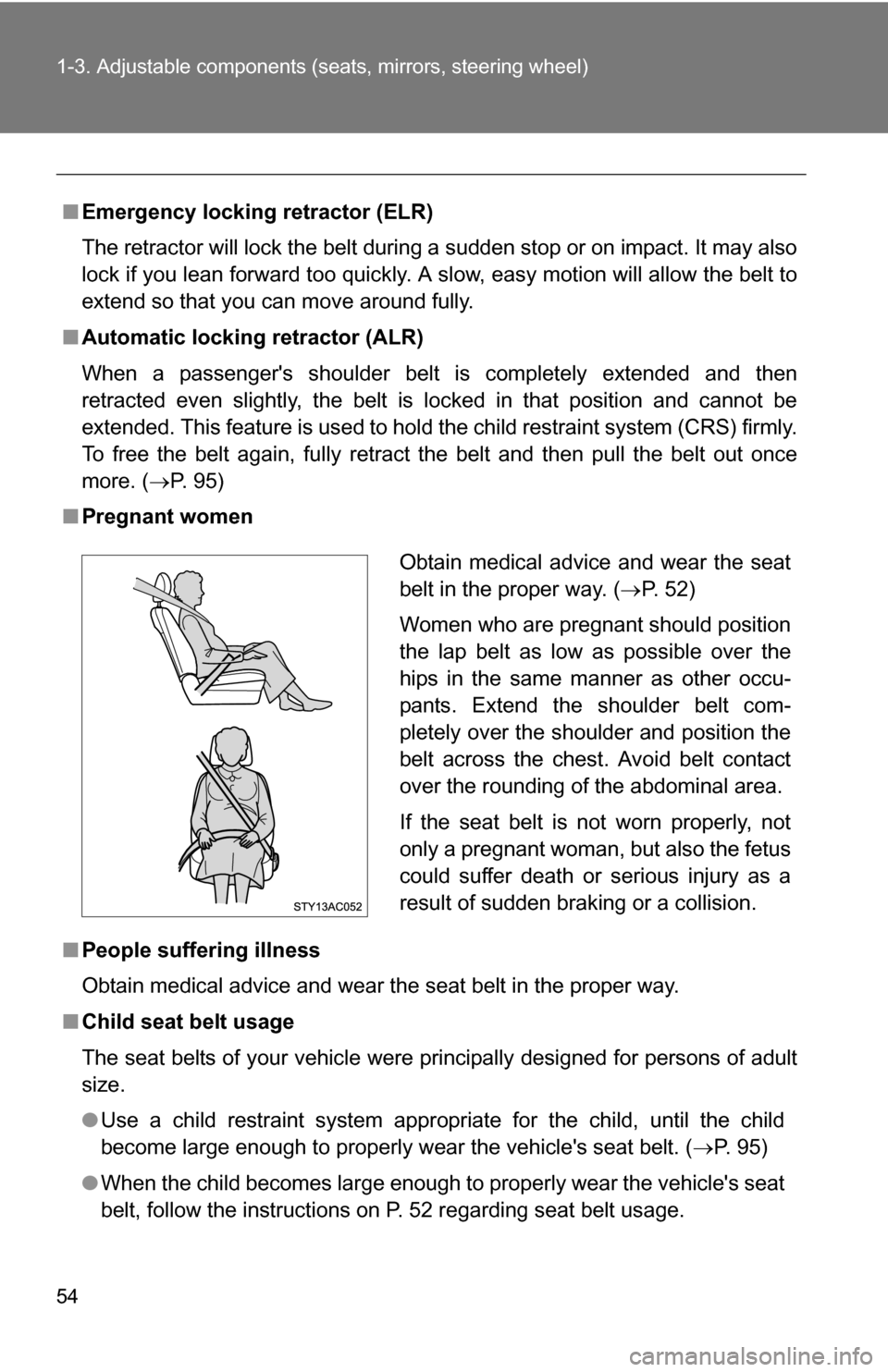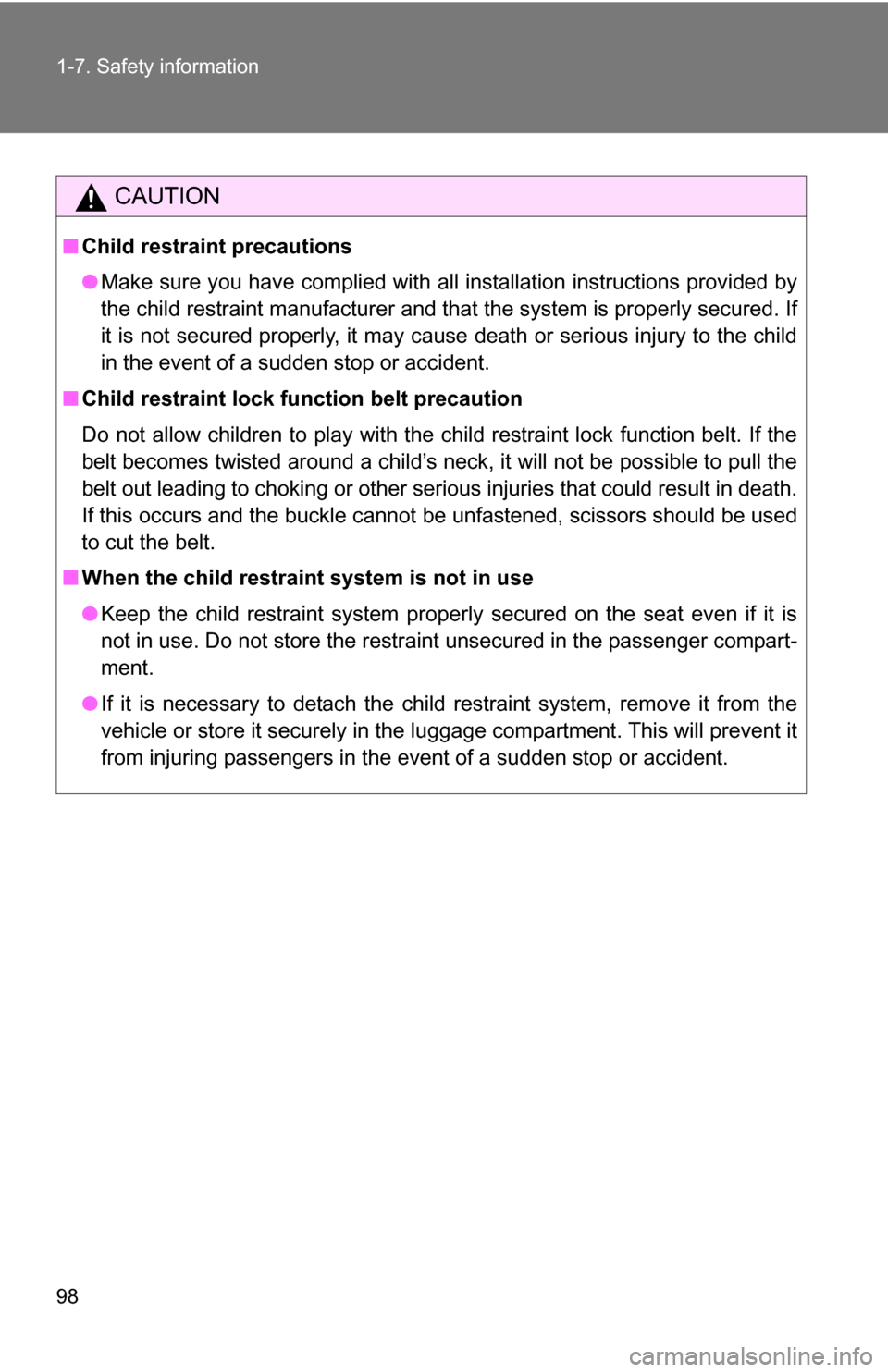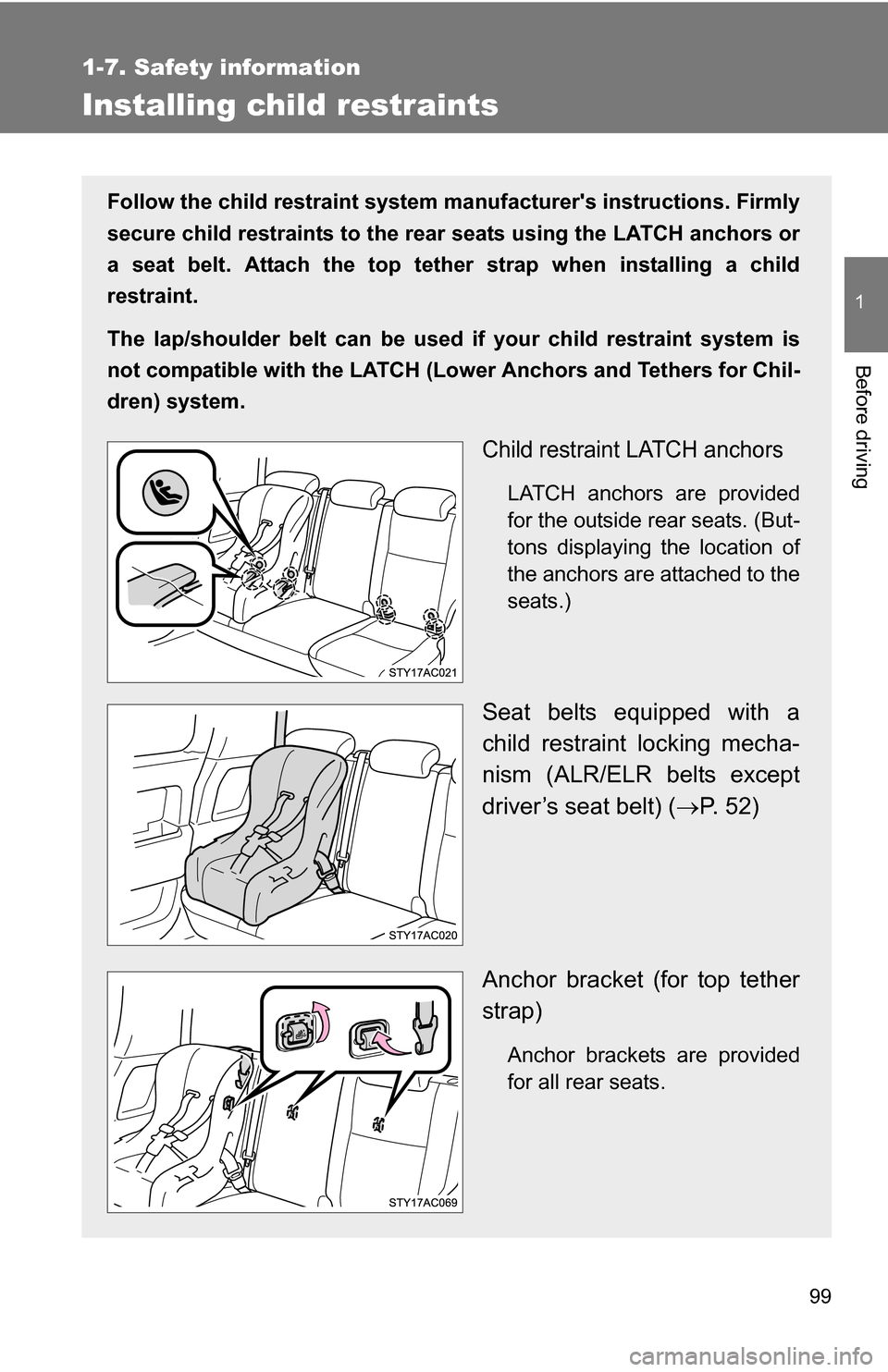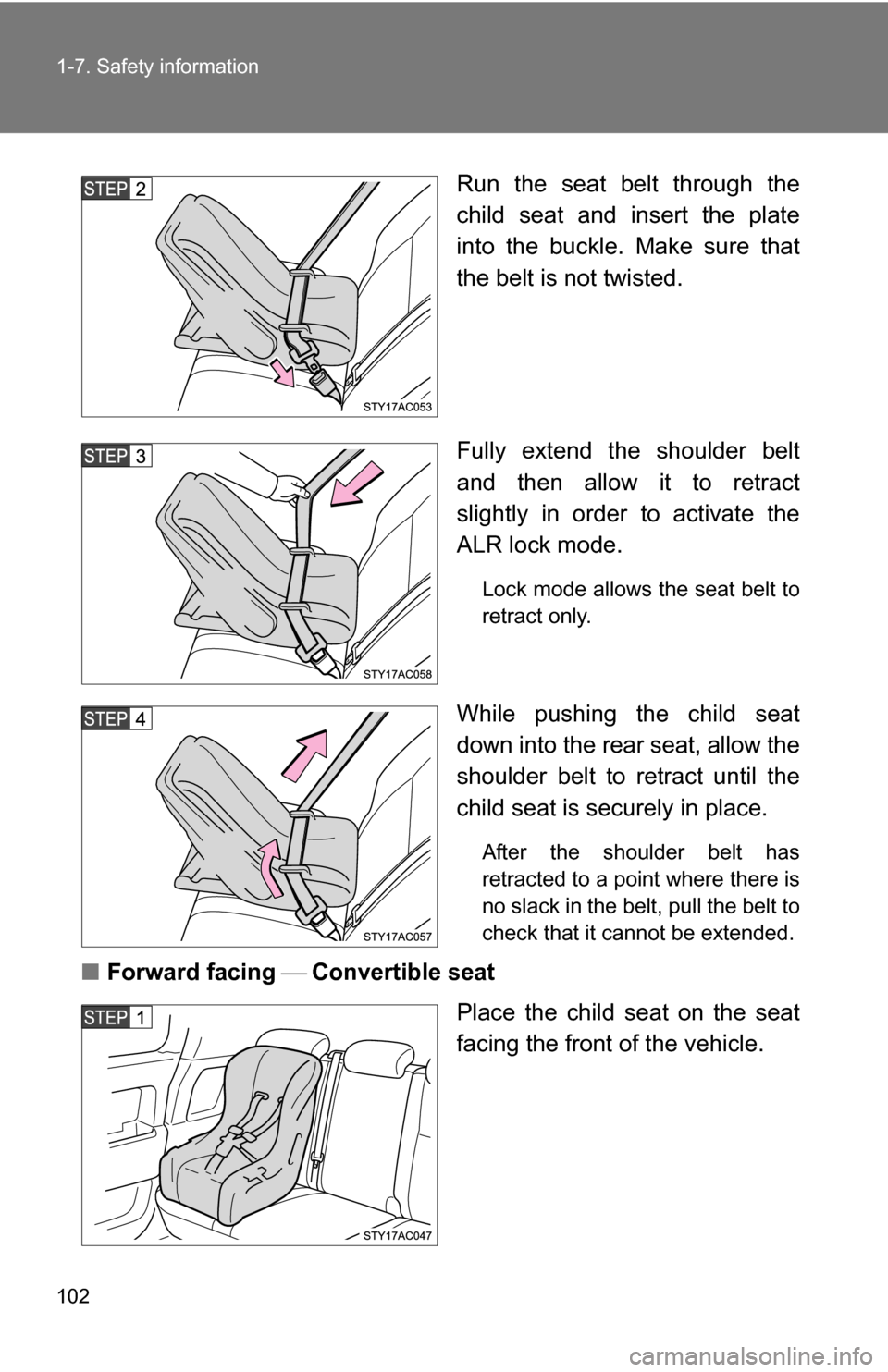2009 TOYOTA FJ CRUISER child lock
[x] Cancel search: child lockPage 2 of 432

TABLE OF CONTENTSIndex
2
1-1. Key informationKeys ..................................... 28
1-2. Opening, closing and locking
the doors
Wireless remote control ...... 30
Side doors ............................ 33
Access doors........................ 36
Back door ............................. 38
Glass hatch .......................... 41
1-3. Adjustable components
(seats, mirrors, steering
wheel)
Front seats ........................... 43
Rear seats ............................ 45
Head restraints ..................... 50
Seat belts ............................. 52
Steering wheel ..................... 58
Anti-glare inside rear view mirror .................................. 59
Outside rear view mirrors ..... 63
1-4. Opening a nd closing the
windo ws
Power windows .................... 66
1-5. Refueling Opening the fuel tank cap .... 68 1-6. Theft deterrent system
Engine immobilizer system ................................ 72
Theft prevention labels (U.S.A.)............................... 74
1-7. Safety information Correct driving posture ......... 75
SRS airbags ......................... 77
Front passenger occupant classification system ........... 90
Child restraint systems ......... 95
Installing child restraints ....... 99
2-1. Driving procedures Driving the vehicle .............. 110
Engine (ignition) switch....... 120
Automatic
Transmission...... 123
Manual Transmission ......... 125
Turn signal lever ................. 127
Parking brake ..................... 128
Horn .................................... 130
2-2. Instrument cluster Gauges and meters ............ 131
Indicators and warning lights ................................. 134
Accessory meter ................. 137
2-3. Operating the li ghts and
wipers
Headlight switch ................. 139
Windshield wipers and washer .............................. 141
1Before driving
2When driving
Page 27 of 432

Before driving1
27
1-1. Key informationKeys ................................... 28
1-2. Opening, closing and locking the doors
Wireless remote control ... 30
Side doors .......................... 33
Access doors ..................... 36
Back door ........................... 38
Glass hatch ........................ 41
1-3. Adjustable components (seats, mirrors, steering
wheel)
Front seats ......................... 43
Rear seats.......................... 45
Head restraints................... 50
Seat belts ........................... 52
Steering wheel ................... 58
Anti-glare inside rear view mirror ............................... 59
Outside rear view mirrors ... 63
1-4. Opening and closing the windows
Power windows .................. 66
1-5. Refueling Opening the fuel tank cap ................................... 68 1-6. Theft deterrent system
Engine immobilizer system ............................. 72
Theft prevention labels (U.S.A.) ............................ 74
1-7. Safety information Correct driving posture....... 75
SRS airbags ....................... 77
Front passenger occupant classification system ........ 90
Child restraint systems....... 95
Installing child restraints..... 99
Page 54 of 432

54 1-3. Adjustable components (seats, mirrors, steering wheel)
■Emergency locking retractor (ELR)
The retractor will lock the belt during a sudden stop or on impact. It may also
lock if you lean forward too quickly. A slow, easy motion will allow the belt to
extend so that you can move around fully.
■ Automatic locking retractor (ALR)
When a passenger's shoulder belt is completely extended and then
retracted even slightly, the belt is locked in that position and cannot be
extended. This feature is used to hold the child restraint system (CRS) firmly.
To free the belt again, fully retract the belt and then pull the belt out once
more. ( P. 95)
■ Pregnant women
■ People suffering illness
Obtain medical advice and wear the seat belt in the proper way.
■ Child seat belt usage
The seat belts of your vehicle were principally designed for persons of adult
size.
●Use a child restraint system appropriate for the child, until the child
become large enough to properly wear the vehicle's seat belt. ( P. 95)
● When the child becomes large enough to properly wear the vehicle's seat
belt, follow the instructions on P. 52 regarding seat belt usage.
Obtain medical advice and wear the seat
belt in the proper way. ( P. 52)
Women who are pregnant should position
the lap belt as low as possible over the
hips in the same manner as other occu-
pants. Extend the shoulder belt com-
pletely over the shoulder and position the
belt across the chest. Avoid belt contact
over the rounding of the abdominal area.
If the seat belt is not worn properly, not
only a pregnant woman, but also the fetus
could suffer death or serious injury as a
result of sudden braking or a collision.
Page 56 of 432

56 1-3. Adjustable components (seats, mirrors, steering wheel)
CAUTION
■Adjustable shoulder anchor
Always make sure the shoulder belt is positioned across the center of your
shoulder. The belt should be kept away from your neck, but not falling off
your shoulder. Failure to do so could reduce the amount of protection in an
accident and cause death or serious injuries in a collision. ( P. 53)
■ Seat belt pretensioners
●Do not place anything, such as a cushion, on the front passenger’s seat.
Doing so will disperse the passenger’s weight, which prevents the sensor
from detecting the passenger’s weight properly. As a result, the seat belt
pretensioner for the front passenger’s seat may not activate in the event of
a collision.
● If the pretensioner has activated, the seat belt becomes locked: it cannot
be further extended, nor will it return to the stowed position. The seat belt
cannot be used again and must be replaced at your Toyota dealer.
■ Child restraint lock function belt precaution
Do not allow children to play with the child restraint lock function belt. If the
belt becomes twisted around a child’s neck, it will not be possible to pull the
belt out leading to choking or other serious injuries that could result in death.
If this occurs and the buckle cannot be unfastened, scissors should be used
to cut the belt.
■ Seat belt damage and wear
●Do not damage the seat belts by allowing the belt, plate, or buckle to be
jammed in the door.
● Inspect the seat belt system periodically. Check for cuts, fraying, and loose
parts. Do not use a damaged seat belt until it is replaced. Damaged seat
belt cannot protect an occupant from death or serious injury.
● Ensure that the belt and tab are locked and the belt is not twisted.
If the seat belt does not function correctly, immediately contact your Toyota
dealer.
● Replace the seat assembly, including the belts, if your vehicle has been
involved in a serious accident, even if there is no obvious damage.
Page 98 of 432

98 1-7. Safety information
CAUTION
■Child restraint precautions
●Make sure you have complied with all installation instructions provided by
the child restraint manufacturer and that the system is properly secured. If
it is not secured properly, it may cause death or serious injury to the child
in the event of a sudden stop or accident.
■ Child restraint lock function belt precaution
Do not allow children to play with the child restraint lock function belt. If the
belt becomes twisted around a child’s neck, it will not be possible to pull the
belt out leading to choking or other serious injuries that could result in death.
If this occurs and the buckle cannot be unfastened, scissors should be used
to cut the belt.
■ When the child restrain t system is not in use
● Keep the child restraint system properly secured on the seat even if it is
not in use. Do not store the restraint unsecured in the passenger compart-
ment.
● If it is necessary to detach the child restraint system, remove it from the
vehicle or store it securely in the luggage compartment. This will prevent it
from injuring passengers in the event of a sudden stop or accident.
Page 99 of 432

99
1
1-7. Safety information
Before driving
Installing child restraints
Follow the child restraint system manufacturer's instructions. Firmly
secure child restraints to the r ear seats using the LATCH anchors or
a seat belt. Attach the top teth er strap when installing a child
restraint.
The lap/shoulder belt can be used if your child restraint system is
not compatible with the LATCH (Low er Anchors and Tethers for Chil-
dren) system.
Child restraint LATCH anchors
LATCH anchors are provided
for the outside rear seats. (But-
tons displaying the location of
the anchors are attached to the
seats.)
Seat belts equipped with a
child restraint locking mecha-
nism (ALR/ELR belts except
driver’s seat belt) ( P. 52)
Anchor bracket (for top tether
strap)
Anchor brackets are provided
for all rear seats.
Page 101 of 432

101
1-7. Safety information
1
Before driving
Type B
Widen the gap between
the seat cushion and
seatback slightly.
Latch the buckles onto
the LATCH anchors.
If the child restraint has a
top tether strap, the top
tether strap should be
latched onto the top
tether strap anchor.
( P. 105)
For owners in Canada:
The symbol on a child restraint
system indicates the presence of
a lower connector system.
Installing child restraints using a seat belt (child restraint lock function belt)
■ Rear facing Infant seat/convertible seat
Place the child seat on the rear
seat facing the rear of the vehi-
cle.
Canada
only
Page 102 of 432

102 1-7. Safety information
Run the seat belt through the
child seat and insert the plate
into the buckle. Make sure that
the belt is not twisted.
Fully extend the shoulder belt
and then allow it to retract
slightly in order to activate the
ALR lock mode.
Lock mode allows the seat belt to
retract only.
While pushing the child seat
down into the rear seat, allow the
shoulder belt to retract until the
child seat is securely in place.
After the shoulder belt has
retracted to a point where there is
no slack in the belt, pull the belt to
check that it cannot be extended.
■Forward facing Convertible seat
Place the child seat on the seat
facing the front of the vehicle.